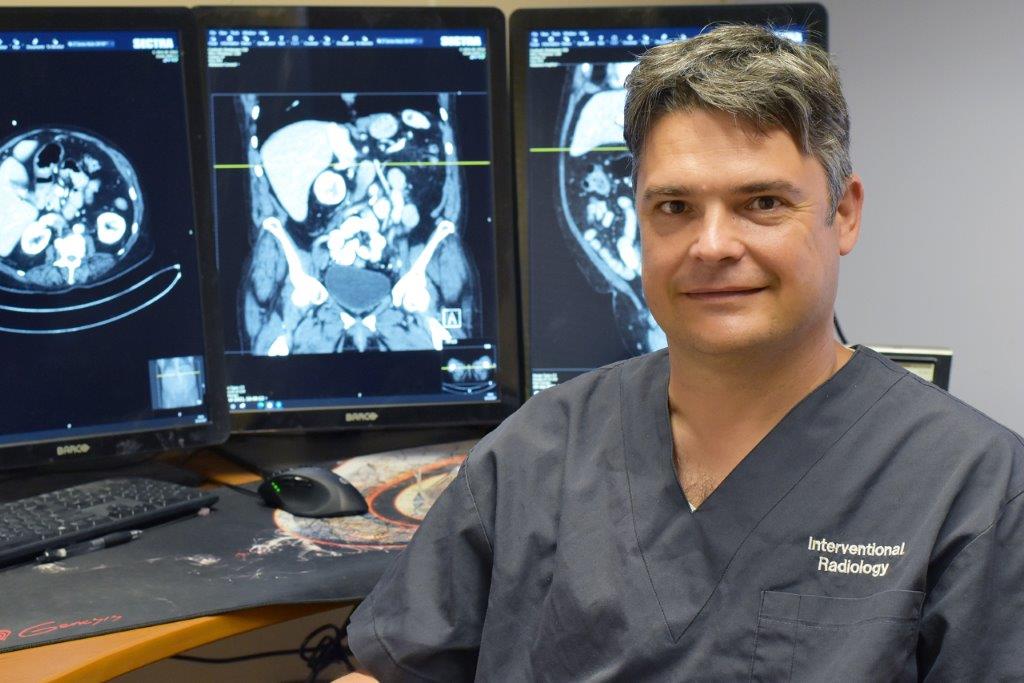New Kidney Cancer Treatment Burns Tumours Using Radio Waves
Published Tuesday, August 3, 2021

New Kidney Cancer Treatment Burns Tumours Using Radio Waves
by Graham Strong
Traditionally, kidney cancer tumours are treated with surgery. This is still the gold standard for many reasons including the fact that doctors can examine the tumour in the lab afterwards to ensure they removed all of it.
However, because of age or other health conditions, surgery might be too risky for some patients. Those are the patients Dr. Radu Rozenberg and Dr. Walid Shahrour had in mind when they wanted to bring a new type of minimally invasive kidney cancer treatment to Northwestern Ontario.
Called radio frequency ablation or RFA, the procedure uses a small needle that gives off a radio signal. This signal is so powerful that it literally burns any tissue around it – including cancer cells. The procedure takes approximately two hours. Doctors spend most of the time spent carefully positioning the needle – with the help of a CT scanner – to avoid healthy tissue. The actual burning only takes about 12 to 14 minutes to complete.
The doctors treated the first two patients at the Thunder Bay Regional Health Sciences Centre with this procedure in May.
“It’s an alternative to a debilitating procedure like open surgery that might be too hard for them to go through,” said. Dr. Rozenberg, an interventional radiologist at our Hospital.
“We’re limited to a certain size of tumour – we can’t treat large tumours this way,” said urologist Dr. Shahrour. The maximum size that can be treated with RFA is about four centimetres. “But still, it’s another treatment option for people who would otherwise have no option. It’s an amazing procedure.”
Local RFA Reduces Travel for Patients
Dr. Shahrour added that previously he sent urology patients to southern Ontario for the procedure. But with the pandemic, that wasn’t possible. Besides, patients who are at higher risk during surgery also tend to be higher risk for travel, too.
“It’s not right to make patients travel all the way to Toronto,” Dr. Rozenberg said. “Now, we can do it right here in Thunder Bay.”
Because it’s minimally invasive, recovery time is much faster – most patients will be able to go home the same day. There is also less pain along with less risk of infection and other complications due to surgery.
RFA is part of a larger ablation program that the doctors are developing. The other two treatments are cryoablation – burning cancer cells with extreme cold instead of extreme heat – and microwave ablation. Different methods can be used in different situations, Dr. Rozenberg said.
For example, RFA is usually used for tumours that are farther away from sensitive parts of the kidney or other organs to avoid damaging those areas. Cryoablation is safer to use in areas closer to these sensitive areas.
In every case, a multidisciplinary team involving urologists, interventional radiologists, oncologists, and others meets to discuss the best treatment plan for each individual patient.
The new program took over a year to bring together including purchasing the equipment, upgrading training, and getting the right provincial approvals. It was a team effort all the way.
“I really appreciate the relationship we have with the Urology Department,” Dr. Rozenberg said.
“Dr. Rozenberg has done an amazing job developing this program – I have to commend him for that,” Dr. Shahrour said.
You can help fund similar programs to this one that help bring more treatments closer to home. Make your donation online at healthsciencesfoundation.ca/donate or call our Donation Centre at (807) 345-4673. Together, we are making more procedures like RFA possible!